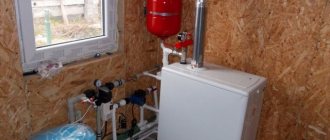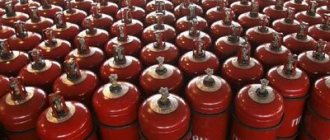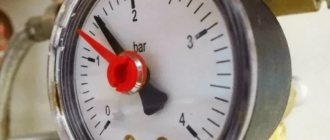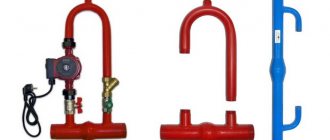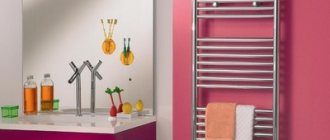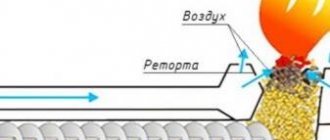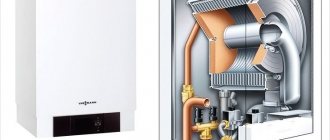From the author: Hello, dear friends! Surely, those of you who live in a private home know how important it is to monitor the correct operation of the heating system. Often, water, which plays the role of a coolant, freezes, and this can lead to serious problems.
Anticipating this scenario, homeowners fill the heating system not with water, but with a special compound - antifreeze. Is it possible to pour antifreeze into batteries, and if so, how to use this composition correctly? We will look at the types of antifreeze, dwell on the pros and cons and decide whether antifreeze can be poured into the heating system .
In what cases should antifreeze not be used?
Why is the question posed this way? Everything is very simple - you can easily familiarize yourself with the specific positive qualities of any brand of antifreeze. Such information is actively distributed by manufacturers. For our part, we want to present those features of this technical fluid that they are trying to keep silent about:
- Antifreeze cannot be used in double-circuit boilers - it is possible to mix coolant from the heating circuit into the water supply circuit. As is known, non-freezing liquid is poisonous due to its physical and chemical properties.
- It also cannot be used in open systems - evaporation of the coolant is possible.
- It is unacceptable to use antifreeze in a system with a galvanized pipeline - it is fraught with chemical changes and loss of its original properties.
- The heat capacity of non-freezing liquid is lower than that of water, which means that radiator batteries of higher power will be required.
- The viscosity of antifreeze is also higher - more powerful circulation pumps are needed.
The container for antifreeze must be of sufficient volume and correctly calculated according to the project
Limitations and Cautions
As mentioned, you should choose the right anti-freeze for the heating system of a private house, depending on its type. In addition, you need to consider that it is not suitable for all boilers. If the recommendations are ignored, the equipment may fail due to damage to the pipes.
It is not recommended to use antifreeze if the equipment has a galvanized surface. In this case, the protective layer quickly collapses, and the element will fail over time. Since it has a high viscosity, the heating system must be equipped with additional circulation pumps. Moreover, their productivity depends on the critical level of freezing temperature: the lower it is, the higher the productivity should be.
Antifreeze must be changed strictly according to the manufacturer's instructions. Over time, it loses its properties, which negatively affects the operation of the entire system. It is not recommended to use automotive antifreeze, since they are made primarily from unsafe substances.
If antifreeze is in the form of a concentrate, it should only be diluted in distilled water. Running water contains many foreign substances that, when combined, can cause a dangerous chemical reaction.
Propylene glycol antifreeze
Propylene glycol in the heating system is not as toxic as the previous type. Such antifreeze may contain food additives that are not even dangerous to human health.
True, such a coolant may contain various additives that can affect the materials from which various elements of the heating system are made. How additives work depends on the material from which the heating system components are made. Some additives are needed to prevent various oxidation or foam formations from occurring inside the heating system.
Propylene glycol antifreeze
Features when starting the heating system
Different compositions of solutions affect the operation of the heating system. Thus, the presence of ethylene glycol affects the initial stage of system startup. The heating process must be started at low power, then gradually increased to the required level. This method will reduce the toxic effects of this substance.
A product based on propylene glycol does not require such adjustments when starting heating equipment.
When all the requirements are met, then there is no need to be afraid of using “anti-freeze” as a coolant. It will solve a lot of problems if used skillfully.
Prices for non-freezing liquid vary, and so does the quality. The policy here should be this: when it is not possible to buy a good product, it is better to stick with water. In this case, you must ensure that the coolant is drained from the system before the onset of frost, or turn on the heating devices on time.
Other components
Recipes for factory-made antifreeze liquids necessarily contain surfactants. They are designed to remove dirt, soot, grime, oil and anything else that may limit visibility from the glass surface.
For a liquid to be effective in cleaning glass, very few surfactants are required. Flavorings are also used in the production process. They serve to give the product a pleasant smell. Manufacturers often use the scent of apples, citrus fruits or any other product with a persistent and “tasty” aroma. Dyes color liquids in different colors. This makes it easier for the buyer to identify the desired product. Separately, it is necessary to say about water. For the manufacture of the highest class products, distilled is best suited. In some cases, it is possible to use artesian water with a minimum of salts. But the most ordinary one (from the tap) is not suitable for making anti-freeze.
If you take anti-freeze, what brand?
Liquids for heating systems
Today's market offers varied offerings of these specific products.
However, there are also leaders here. Heating fluid called “Warm Home” is in great demand among consumers. This product is produced in Russia.
“Warm House” has been successfully used for many years, so we can confidently say that the liquid has stood the test of time. And this antifreeze is best characterized by reviews from homeowners who have considerable experience in operating heating systems using antifreeze liquid.
According to them, this brand does not lose its characteristics over ten heating seasons.
This fully corresponds to the service life declared by the manufacturer. As you know, reviews from satisfied consumers are the best proof of quality.
Also popular are brands such as Energos Universal, Energos Lux, Thermagent, Dixis, etc.
Russian manufacturers produce antifreezes based on ethylene glycol in two versions: with a freezing temperature of up to -30°C, and also with a freezing temperature of up to -65°C.
The above-mentioned manufacturers are actively expanding their range of non-freezing coolants made from food-grade propylene glycol, an environmentally friendly raw material. And this is not in vain, because the demand for heating antifreeze is growing, which means there must be supply.
Cases in which the use of antifreeze is strictly prohibited
When not to use antifreeze
It is not difficult to familiarize yourself with all the advantages of antifreeze from any manufacturer.
This information is actively advertised by brands. On the other hand, we should talk about the features of this liquid, which manufacturers try not to emphasize:
- It is prohibited to use antifreeze in double-circuit boilers. After all, the design features of this heating system are such that coolant can leak from the heating duct into the water supply circuit. And due to its chemical properties, the non-freezing liquid is poisonous.
- It is strictly forbidden to use antifreeze in open systems; in this case, it may evaporate.
- Also, antifreeze should not be used in heating systems with galvanized pipelines. When interacting with them, loss of original properties and chemical changes are possible. It is not recommended to pour antifreeze into cast iron boilers. At the very least, you need to make sure that your unit contains paronite gaskets that can prevent the harmful effects of antifreeze. The technical data sheet of the product will help you with this.
- The heat capacity of antifreeze is lower than water, as a result, radiator batteries of higher power are needed.
- Since the viscosity of the non-freezing liquid is higher, more powerful circulation pumps will be required.
In any case, the final decision is always yours. It is impossible to say for sure which is better, water or non-freezing liquid.
It all depends on individual heating parameters. Before making a final decision on the choice of a particular coolant, you should seek advice from specialists.
Volume calculation and filling
To avoid emergency situations, liquid must be poured into the heating system strictly in a certain volume. It is calculated taking into account the following factors:
- type of heating system;
- its material;
- internal volume of the boiler;
- the area of the room that is planned to be heated.
It is recommended to carry out calculations according to the instructions for the equipment, and also take into account whether antifreeze can be used in it at all. But there are situations when the technical documentation does not contain any information on this matter, then the calculation is carried out by studying the relevant literature. And in some cases, you will need the help of a specialist who will help you carry out all the calculations and put the system into operation.
After filling, do not forget to test the equipment
You also need to know how to properly fill the coolant into the system. If there is already old media in it, then it will need to be drained. It is also necessary to check the degree of contamination; the system may need to be cleaned first, otherwise mixing two anti-freeze agents will cause an unexpected chemical reaction.
In a closed system, the filling point should be located below other heating devices. Antifreeze is poured using pumping equipment, but the pressure in the pipes must be no higher than 3 atmospheres. And if it is open, then filling must be done through the upper expansion tank.
After this, the operation of the equipment is tested. The temperature in the system increases, during which the tightness of the components and the absence of unnecessary noise during the circulation of the coolant are checked.
During the period of use of the system, antifreeze will need to be added periodically, so it is better to purchase it with some reserve.
Antifreeze classification
There are many types of these products on the market. Antifreeze liquid for heating boilers can be made based on an aqueous solution of glycerin, ethylene glycol, propylene glycol, and so on. Since all substances are highly aggressive, the liquids contain special additives.
Each type has certain specific characteristics:
- Ethylene glycol-based liquid is common among buyers because it has the most affordable price. But it is the most toxic and cannot be used for double-circuit boilers. May pose a health hazard if released into water supplies. If the boiling point rises above 110 degrees, the substance may produce a precipitate that can stop the operation of a number of system elements;
- from propylene glycol - the properties of the composition are almost similar to the previous one, but it is less harmful and safer;
- based on glycerin - environmentally friendly antifreeze, non-toxic, protects the system from corrosion. When it turns into a solid state, it does not increase its volume, and in order for the system to start, it just needs to be warmed up;
- from a natural bischofite solution - has a high level of heat transfer and heat capacity, the freezing point is low and the boiling point is high;
- salt carriers - are produced on the basis of solutions of sodium, calcium and other mineral salts. They have high corrosiveness to pipes.
Recommendations for selection
Water, unlike any antifreeze, is an environmentally friendly liquid. However, it can cause scale and corrosion. However, if the family lives in the house permanently, water is a more acceptable option for heating.
But special liquids are best used when the heating is turned on from time to time during the cold season. The fact is that if the heating was not started when cold weather set in, there is a risk of pipe breakage due to an increase in the volume of water when it turns into a solid state. With antifreeze this problem is eliminated.
How to make anti-freeze: main points
Whatever composition you prepare, it should:
- clean the windshield from dirt and ice;
- remain liquid at subzero temperatures;
- be safe for both humans and machine parts.
That's all, perhaps, nothing more is required from the washer.
As a rule, the base of non-freezing liquid includes ordinary distilled water, alcohol and some additives for fragrance, coloring and improving cleaning properties. Among the alcohols used in production are methyl, ethyl and isopropyl.
Methyl alcohol is harmful to health, so anti-freeze products based on it are prohibited in Russia. And even if you have a canister of this substance lying around somewhere in your garage, you should not pour it into your car.
Isopropyl alcohol is extremely rare among people; this technical liquid has a pungent odor. You can ask someone who repairs and cleans office equipment at home. True, such a master usually doesn’t have more than half a liter in stock. And by the way, it costs much more than ethanol.
Ethyl alcohol is the most affordable option. Many people have a bottle of medical, technical or even food grade ethanol at home. However, no one has canceled our favorite vodka either, because in essence it is an aqueous solution of ethyl alcohol.
To make anti-freeze in the washer at home, many also use salt, acids, and detergents. But first things first.
Can antifreeze be used?
heat supply diagram with antifreeze instead of water
Antifreeze or antifreeze liquids are known to almost everyone. They are widely used in car cooling systems in winter. In a car engine, antifreeze transfers excess heat away from the engine, cooling it. Moreover, even in the most severe frosts it does not freeze. It is these properties - the ability to transfer heat even at the lowest temperatures - that led to the use of antifreeze for the construction of heating systems. It is especially important to use such a coolant in a system where part of the pipeline runs through open areas.
A good feature of “anti-freeze” is that it provokes less corrosion on the inner surface of pipeline systems than ordinary water. Another undoubted advantage is the absence of suspended limestone solutions in non-freezing liquids - so you don’t have to worry about possible scale formation.
There are several modifications of antifreeze liquids that can be used in heating systems. The choice of a specific type is made taking into account the climatic conditions and configuration of the heating system of your home.
What is flushing fluid for the heating system and does it need to be flushed?
In addition to the coolant itself, when operating the heating system, you will also have to purchase a liquid intended for flushing the pipeline and heating radiators.
Of course, as a last resort, you can wash the inner surface of the pipes with ordinary tap water, but it is better to do this with the help of special liquids that contain special chemical additives.
heating flushing
An alternative washing option may be to use water with a caustic soda solution added to it. This mixture is poured into the heating system and remains inside it for about an hour. The soda solution comes into contact with the scale on the inner surface of the system and dissolves it. In addition, the baking soda solution will dissolve areas with corrosion.
How to choose a liquid for a heating system?
First of all, it is necessary to determine the operating parameters of the system. Here two extreme values will be important to you - the maximum coolant temperature when heating in the boiler and the minimum ambient temperature. Next, you need to carefully study the technical characteristics of your heating system
Actually, the main attention should be paid to the characteristics of the heat exchanger in the boiler. Some manufacturers may not allow the use of antifreeze fluids. And finally, after determining the admissibility of using non-freezing liquid and its possible temperature parameters, proceed directly to choosing the brand of liquid, focusing on its lowest toxicity
Still, the heating system will be located in a living room, and possible liquid leaks should not lead to poisoning.
Using alcohol as a coolant
No matter how blasphemous it may sound to the male ear, it is allowed to use alcohol as a coolant. Alcohol does not freeze and can be used in a wide range of temperatures. Naturally, industrial alcohol is used in this capacity, which is a deadly poison for humans. However, many manufacturers of boilers and heat exchangers are critical of the use of liquids such as bischofite or ethylene glycol as a coolant.
bischofite
The disadvantage of using pure alcohol as a coolant is its high volatility - about five liters per year will evaporate through microscopic pores in the system.
Advantages
The use of antifreeze is considered an ideal solution for regions with cold climates. In addition, it is perfect for use in homes where the room is not heated for some time. Antifreeze liquid has increased viscosity. This property can be eliminated by adding clean water in permitted proportions. This allows you to save a noticeable amount of coolant, and therefore money. In addition, circulation pumps will work much longer, since they will not work at full capacity.
Main advantages:
- there is no need to drain the coolant from the system when it is turned off for a significant period;
- all components of the heating system remain filled with liquid, which prevents direct access of oxygen and, accordingly, corrosion;
- additional additives inhibit the formation of corrosion and scale;
- the freezing temperature of the coolant ranges from -30 to -65 - it all depends on the amount of added water;
- heating can be started without any unpleasant surprises in the form of a cracked pipe or anything else.
Important! Anti-freeze helps extend the life of heating system components.
Types of low-freezing liquids
Non-freezing liquid for heating a house is the same as antifreeze or antifreeze. doesn't matter. More precisely, there is a difference, but it concerns more the composition of antifreezes than the basic properties. And their main property is not to turn into ice when the temperature drops, down to -60 degrees. At the same time, the cooled composition thickens.
Propylene glycol is part of an environmentally friendly antifreeze
Any heating liquid is non-freezing, a warm house in particular is made according to the same principle. Their composition:
- glycol (alcohol) base;
- main active ingredient;
- substances that prevent corrosion (inhibitors);
- substances responsible for the characteristics of the composition (additives).
So, it is already clear that non-freezing liquid for water heating is an alcoholic substance. Glycol itself is not dangerous, but some additives can be very harmful to health. The active component in anti-freeze products can be:
Ethylene glycol liquid, in which ethylene glycol acts as the active substance, is strictly not recommended for use in permanent homes. It is very toxic; if it gets on the skin, it causes burns. If the composition enters a person in the form of a liquid or gas, it leads to serious consequences, including death.
Low-quality antifreeze and the well-known engine antifreeze, which is also sometimes poured into heating systems, are made on an ethylene basis. If there is even the slightest possibility of human contact with ethylene glycol, then it is better to refuse its use:
- evaporation from an open type expansion tank;
- a leak;
- mixing into the DHW circuit in double-circuit boilers.
You cannot use ethylene glycol antifreeze liquids for heating, where a double-circuit boiler acts as a heater.
Propylene glycol non-freezing liquid for heating boilers is completely non-toxic. This does not mean that it can be drunk, but accidental contact in minimal doses on the skin or even internally will not lead to health complications. This antifreeze can be used safely.
Glycerin antifreeze liquid has been poured into the heating system since the mid-twentieth century and is still successfully used to this day. Glycerin is, in general, a universal remedy. What is characteristic is that, unlike the two types of anti-freeze listed above, glycerin does not dry out the rubber, but, on the contrary, restores it and gives it a second life. That is, it acts on it like a silicone lubricant, so you don’t have to worry about the condition of the rubber seals.
The problem of heating a winter greenhouse has been solved, everything is quite simple.
Advantages and disadvantages
The special liquid has a number of features. It has both pros and cons. Benefits of antifreeze:
- the composition retains its characteristics and properties, even if it is constantly in the heating system;
- does not freeze at sub-zero temperatures;
- scale does not form in equipment and pipes;
- does not affect the condition of seals and gaskets: they will not dissolve, dry out or swell.
But when pouring non-freezing liquid into the heating system, there are also disadvantages:
- it has lower heat transfer properties;
- acts aggressively towards metal;
- in the event of a leak, harmful substances will be released.
In addition, antifreeze is viscous, so when choosing equipment for a heating system, you need to take its characteristics into account.
In this video you will learn the benefits of anti-freeze:
How to choose the right heating fluid
It is difficult to imagine comfortable living in an apartment or private house in winter without high-quality heating. Residents of urban high-rise buildings with centralized heating are lucky. After all, there is no need to think or worry about the safety of pipes during the cold period. Maintenance falls on the shoulders of housing maintenance offices. But you have to monitor the proper operation of the autonomous heating system in the private sector yourself.
A coolant is used as a heating element in the heating network. It is a heating fluid that circulates through the circuit. May be of different types. The operation and maintenance of the system depends on what kind of liquid is used. Therefore, this article will focus on the coolant, its types and rules of use.
Characteristics of non-freezing liquids for heating
How low-freezing liquid for heating systems behaves in the circuit is primarily influenced by the quality of the additive package and, of course, operating conditions. Regardless of what main active element is added to the glycol base, all compositions have anti-corrosion and anti-foaming properties.
Without these additives, heating fluid is very aggressive. All antifreezes foam, but glycerin antifreeze liquids for home heating systems especially. Foam is an air-containing substance, and air leads to disruption of circulation, the formation of air pockets, as well as water hammer in the heating system.
The additive package has its own temporary resource. After a certain time, additives break down at the molecular level.
In this case, a precipitate forms and acid is released. It turns out that nothing can smooth out the aggressiveness of the coolant for heating the house, and moreover, everything is aggravated by the release of acid. Service life of antifreeze liquid:
- based on ethylene glycol – five years;
- based on propylene glycol – five years;
- glycerin-based - up to ten years.
This is the service life of the composition under favorable operating conditions. The main requirement is, of course, temperature. When the coolant temperature rises to 90 degrees, the non-freezing liquid begins to disintegrate and loses its properties. This only happens if the boiler is not started correctly after a long period of inactivity, or if there are errors during installation.
Direct contact of the heat exchanger with the flame is undesirable if antifreeze is poured into the circuit
For example, when a heat exchanger is built into a conventional oven. Some install it so that it comes into contact with an open flame. If you plan to use antifreeze for stove heating, then you cannot do this. It is necessary that there is a layer of brick between the heat exchanger and the flame. It will protect the coolant from too hot flames and distribute the heat evenly. In this case, the non-freezing liquid for stove heating will not overheat.
Characteristics that are affected by the quality of the additive package:
- thermal conductivity;
- density;
- viscosity;
- fluidity;
- thermal expansion.
The better the additives, the higher the performance will be. That is, as close as possible to the characteristics of water. In the case of the coefficient of thermal expansion, it should be as small as possible.
Considering the fact that the volumetric expansion of the antifreeze is greater than that of water, it is necessary to provide an expansion chamber with a 40% larger volume.
The thermal conductivity of antifreeze is lower than that of water. Glycerin antifreeze liquids have the lowest thermal conductivity. In relation to water, it is only 85%; for other anti-freeze products the figure can reach 90%. As you can see, the difference is not that big.
Antifreeze liquids are half as dense and viscous as water. These qualities make circulation difficult. To pump the coolant through the circuit, you will need a pump of greater power, and it would also be a good idea to assemble a heating circuit from pipes with a cross-section that is one step larger. For example, if we are talking about polypropylene pipes. then instead of 25 diameter, it is better to take 32.
Despite the fact that antifreeze liquid is denser and more viscous, it has a lower surface tension coefficient, that is, it is more fluid. Do you know that you can fill a glass with heaps of water? The slide, of course, will be small, but even visually it can be seen that the liquid rises above the edge of the vessel. This won't work with anti-freeze. Due to such high fluidity, it flows out where water does not penetrate due to surface tension. In other words, if there are microcracks and even very small holes, then the non-freezing liquid will find its way out there.
Therefore, often, after there was water in the circuit and they decided to pour anti-freeze into it, leaks appear. Main leak points:
- pipe joints;
- connections between radiator sections;
- connection points for additional elements;
- in the boiler itself.
Water has another useful property, thanks to which a minor leak can disappear by itself. Metal particles settle on the edges of cracks and seal them. Of course, this is just scale, which, if the system is flushed and further pressure tested, will be removed and the flow will resume.
Blitz tips
- “Anti-freeze units” are ideal for heating houses that are rarely visited in winter and the system is turned off most of the time;
- Choose special equipment for using antifreeze;
- It is better to purchase radiators with a power 30–40% higher than conventional ones;
- Due to the increased viscosity of antifreeze agents, it is advisable to use pumps with enhanced hydraulics;
- If you need to prepare a solution from the concentrate, use only distilled water for this;
- Do not mix different types of antifreeze; it is better to use one. But if there is no other way out, then first mix them in a container and observe whether a precipitate forms;
- It is unacceptable to use automobile antifreeze in heating structures, since it contains components whose use is unacceptable in residential buildings;
- It is better not to use a concentrate with a freezing threshold of -65 degrees Celsius in its pure form, as this will lead to overheating of the heat exchanger and decomposition of the additives;
- But if the system uses a solution with a freezing temperature of no more than -25 degrees, and the temperature drops below (which is unlikely), then there is no need to worry. The heating installation will not be damaged at all. The antifreeze will thicken, and when the temperature rises, it will return to its original state, without loss of properties.
- To avoid leaks at the sealing joints, you can use automotive sealant.
How to choose the right liquid
Today, there are hundreds of product options on the market for heating devices and consumables for them.
It is quite difficult to choose a high-quality and safe antifreeze among them, because each brand uses all sorts of marketing tricks to attract buyer attention to its product. In order not to fall for the bait set by advertisers, the homeowner needs to understand what requirements the heating boiler fluid poured into the circuit must meet
Before you buy heating fluid. the owner needs to find out some technical characteristics of the boilers, as well as familiarize himself with the list of antifreezes compatible with radiators and pipelines connected to the circuit. In addition, it is necessary to clarify the operating parameters of the heating system and operating features. Next, you should study the specific requirements that specialists place on antifreezes that can make the heating system productive, stable and safe.
You should pay attention to the following parameters:
- Operating temperature range;
- heat capacity;
- inertness of the chemical composition;
- presence of anti-corrosion properties;
- no sediment in the liquid when heated;
- stability of chemical properties - density, viscosity, heat capacity;
- no toxic emissions during use.
Functional liquid fuel, gas and solid fuel heating boilers will last much longer if they are filled with antifreeze with a maximum operating temperature range, a stable chemical composition and acceptable performance characteristics that guarantee protection of heating devices from corrosion, scale and solid sediment. You can buy such liquid only from a trusted manufacturer. But using the wrong antifreeze can lead to a number of undesirable effects.
Negative effects that may appear:
- foam formation inside the circuit when heating the coolant;
- precipitation, which provokes overgrowing of pipes and clogging of the boiler heat exchanger;
- corrosion formation;
- the appearance of leaks;
- violation of the boiler tightness;
- release of toxic substances.

